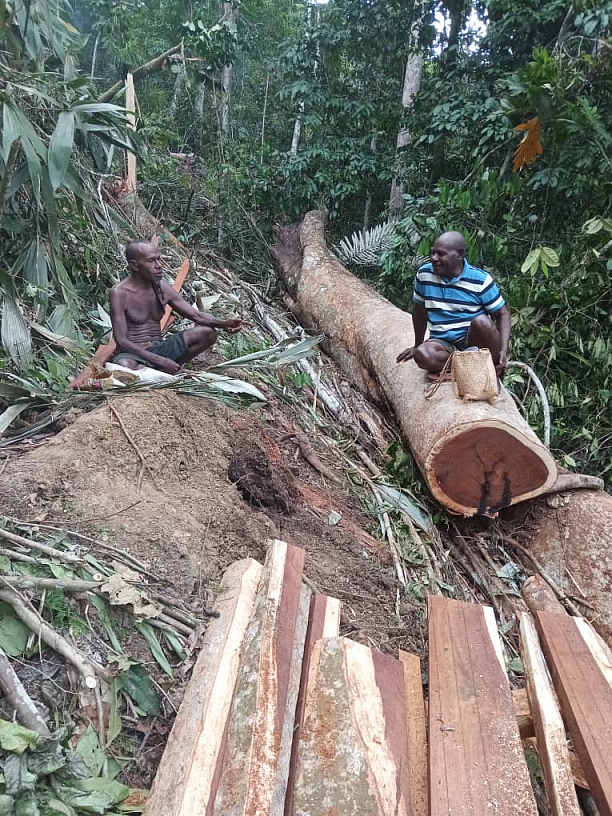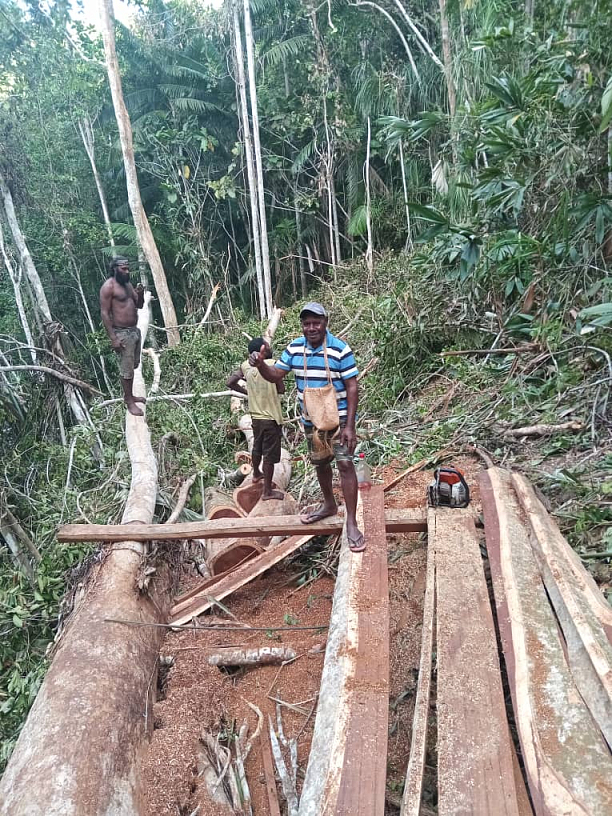62554
SEPIK SPECIAL ECONOMIC ZONE LIMITED
AGRO-FORESTY INVESTMENT
Papua New Guinea
Market: Logging
Stage of the project: Idea or something is already done
Date of last change: 07.10.2024
Papua New Guinea
Market: Logging
Stage of the project: Idea or something is already done
Date of last change: 07.10.2024
Idea
Investment in an Agro-Forestry Project in Papua New Guinea.
Current Status
The proposed investment project is at start-up stage and proposed for development under the Sepik Special Economic Zone Limited. However, the timber resources were harvested some 15 years earlier under a selective logging arrangement by a Malaysian company. So, it is actually not a new project but is being redeveloped under a new company.
Market
The Asian market is close to Papua New Guinea so we will be exporting all our logs, palm oil and cocoa powder toward our northern neighbors. Furthermore, growth prospects in the Asia region are projected to be some of the highest in the world in the next ten years and possibly more. The India and Chinese economies will continue to grow and surpass the United States and Japan. Papua New Guinea stands to benefit immensely from the growth of the Indonesian economy as well. It is poised to be the fifth largest economy in the world by 2030, so these makes are exports very lucrative.
Problem or Opportunity
There is a huge potential for this investment to transition from a logging project into an agricultural project. The logged area will be replaced with oil palm trees and cocoa trees. Sepik Specia Economic Zone Ltd. will continue to manage the agriculture investment over a fifty-year period. Hence, an opportunity for greater financial reward over time.
Solution (product or service)
The Agro-Forestry investment will be located in Papua New Guinea (PNG). It will cover over 75000 hectares of land with a potential to increase by an additional 100000 hectares. After the logging of the 74000 hectares is completed, the logged area will be planted with Oil Palm (40,000 hectares) and Cocoa (34,400). The export potential for logs is huge and so are the export potential of palm oil and cocoa powder. The estimate value of log exports is over $50 million annually while export value for oil palm and cocoa will be over $100 million annually.
Competitors
The competition is not large enough to threaten our business. There is more than enough room for competition at the moment.
Advantages or differentiators
Indisputable Advantages
Access to Exclusive Land: Some logging companies may have long-term leases or ownership rights to specific tracts of forest land that are not available to competitors. This exclusivity can provide a steady supply of timber and unique species.
Established Relationships: Long-standing relationships with landowners, timber suppliers, and local governments can create trust and facilitate smoother operations, making it hard for new entrants to compete on the same level.
Experienced Workforce: A skilled and experienced workforce that has been trained in specialized methods or safety practices can be a significant advantage. This expertise can lead to higher-quality products and safer operations.
Ecosystem Knowledge: An in-depth understanding of local ecosystems and sustainable practices can allow a logging business to operate more effectively while maintaining certifications (like FSC or SFI) that emphasize sustainability.
Innovative Equipment or Methods: Proprietary technology, machinery, or logging methods that improve efficiency, reduce environmental impact, or enhance safety can provide a competitive edge that is difficult to imitate.
Planned or Emphasized Differentiators
Sustainability Practices: Emphasizing eco-friendly logging practices, such as selective logging, reforestation efforts, and minimizing ecosystem disruption, can attract environmentally conscious clients and differentiate the brand.
Transparency in Operations: Offering transparency in sourcing practices and chain of custody, often facilitated by technology, can cultivate trust with consumers and businesses focused on ethical sourcing.
Diverse Product Offerings: Beyond traditional timber, businesses might diversify into specialty wood products, certified sustainable resources, or even non-timber forest products like mushrooms or medicinal plants.
Value-Added Services: Introducing services such as improved logistics, custom timber processing, or consulting on forest management can differentiate a logging business from traditional competitors.
Community Engagement: Actively participating in local communities and emphasizing corporate social responsibility initiatives can create a positive brand image and foster customer loyalty.
Quick Response and Flexibility: Highlighting the ability to quickly adapt to market demands and client needs can set a logging company apart, ensuring customer satisfaction in fluctuating markets.
Access to Exclusive Land: Some logging companies may have long-term leases or ownership rights to specific tracts of forest land that are not available to competitors. This exclusivity can provide a steady supply of timber and unique species.
Established Relationships: Long-standing relationships with landowners, timber suppliers, and local governments can create trust and facilitate smoother operations, making it hard for new entrants to compete on the same level.
Experienced Workforce: A skilled and experienced workforce that has been trained in specialized methods or safety practices can be a significant advantage. This expertise can lead to higher-quality products and safer operations.
Ecosystem Knowledge: An in-depth understanding of local ecosystems and sustainable practices can allow a logging business to operate more effectively while maintaining certifications (like FSC or SFI) that emphasize sustainability.
Innovative Equipment or Methods: Proprietary technology, machinery, or logging methods that improve efficiency, reduce environmental impact, or enhance safety can provide a competitive edge that is difficult to imitate.
Planned or Emphasized Differentiators
Sustainability Practices: Emphasizing eco-friendly logging practices, such as selective logging, reforestation efforts, and minimizing ecosystem disruption, can attract environmentally conscious clients and differentiate the brand.
Transparency in Operations: Offering transparency in sourcing practices and chain of custody, often facilitated by technology, can cultivate trust with consumers and businesses focused on ethical sourcing.
Diverse Product Offerings: Beyond traditional timber, businesses might diversify into specialty wood products, certified sustainable resources, or even non-timber forest products like mushrooms or medicinal plants.
Value-Added Services: Introducing services such as improved logistics, custom timber processing, or consulting on forest management can differentiate a logging business from traditional competitors.
Community Engagement: Actively participating in local communities and emphasizing corporate social responsibility initiatives can create a positive brand image and foster customer loyalty.
Quick Response and Flexibility: Highlighting the ability to quickly adapt to market demands and client needs can set a logging company apart, ensuring customer satisfaction in fluctuating markets.
Finance
Sale of kwila logs at $1200 per cubic metre.
Expected log exports will be:
LOG PRODUCTION & EXPORT INCOME ESTIMATES
Est. export price per cubic metre = $1,200 per cubic metre
Production in Cubic Metres Export Income @ $1,200 per Cu Mtr
Year 1 50,000.00 $ 60,000,000.00
Year 2 70,000.00 $ 84,000,000.00
Year 3 100,000.00 $120,000,000.00
Year 4 140,000.00 $168,000,000.00
Year 5 190,000.00 $228,000,000.00
TOTAL EST. INCOME OVER 5 YEARS: $660,000,000.00
Expected log exports will be:
LOG PRODUCTION & EXPORT INCOME ESTIMATES
Est. export price per cubic metre = $1,200 per cubic metre
Production in Cubic Metres Export Income @ $1,200 per Cu Mtr
Year 1 50,000.00 $ 60,000,000.00
Year 2 70,000.00 $ 84,000,000.00
Year 3 100,000.00 $120,000,000.00
Year 4 140,000.00 $168,000,000.00
Year 5 190,000.00 $228,000,000.00
TOTAL EST. INCOME OVER 5 YEARS: $660,000,000.00
Business model
The business model we will employ is ensure sustainable logging practices are employed. We will ensure that logged areas are replaced with oil palm and cocoa trees to help reduce greenhouse emissions and regenerate the production of oxygen. Both the oil palm and cocoa will be downstream processed locally for export.
Money will be spent on
Project Overview:
A large-scale logging and agro-forestry project involving the clearing of 100,000 hectares of forest, followed by replanting with oil palm and cocoa trees. Logging operations will span five years, after which the focus will shift to agriculture and processing facilities.
Timeline Highlights:
o Year 1-5: Logging operations.
o Year 6-8: Intense planting of oil palm and cocoa.
o Mid-Year 8: Construction of a 30-ton oil palm processing mill and a 20-ton cocoa processing factory.
A large-scale logging and agro-forestry project involving the clearing of 100,000 hectares of forest, followed by replanting with oil palm and cocoa trees. Logging operations will span five years, after which the focus will shift to agriculture and processing facilities.
Timeline Highlights:
o Year 1-5: Logging operations.
o Year 6-8: Intense planting of oil palm and cocoa.
o Mid-Year 8: Construction of a 30-ton oil palm processing mill and a 20-ton cocoa processing factory.
Offer for investor
We are open to offers by the investor as to how they would want to participate in this proposal. They can put in money and be repaid their principal plus interest and have a representation on the board of directors. The investor is free to negotiate their terms and conditions with us.
Team or Management
Risks
1. Competitive Behavior
Price Wars: Competitors may engage in aggressive pricing strategies to win market share, squeezing profit margins for all companies involved.
Market Entrants: New players entering the market with innovative practices or lower costs can disrupt established businesses.
Quality Competition: Competitors that offer superior production techniques that may lead to lower production cost and high profit.
2. Economic Crises
Market Fluctuations: Economic downturns can lead to decreased demand for timber and wood products, affecting sales and profitability.
Financial Instability: Changes in government policies, tariffs, or logging regulations can lead to uncertainty and impact operational budgeting.
Investment Risks: Difficulty in securing financing for machinery, land acquisition, or technology upgrades during economic instability.
3. Environmental Regulations and Crises
Stricter Regulations: Increasingly stringent environmental laws can lead to unforeseen operational costs or limitations on logging activities.
Climate Change: Extreme weather events, such as wildfires or floods, can damage operations, reduce timber availability, and limit forest health.
4. Technological Advances
Disruption by New Technologies: Advances in alternative materials (e.g., engineered wood products, recycled materials) or logging technologies (e.g., drones; automated machinery) can decrease demand for traditional logging services.
Failure to Innovate: A lack of adaptation to new technologies in logistics, processing, and sustainable practices may render a business obsolete.
5. Supply Chain Vulnerabilities
Dependence on Suppliers: Relying heavily on specific suppliers for timber or machinery can create risks if those suppliers face disruptions, such as natural disasters or political instability.
Logistics Challenges: Inefficiencies in transportation and logistics can lead to increased costs and reduced ability to meet customer demands on time.
6. Labor Market Challenges
Shortage of Skilled Labor: Difficulty in recruiting and retaining skilled workers can impact operational efficiency and quality.
Safety Incidents: High-risk work environments can lead to accidents, resulting in injury claims, increased insurance costs, and damage to reputation.
7. Market Demand Uncertainty
Changing Consumer Preferences: A shift towards more sustainable practices might decrease demand for certain timber products, requiring adaptation in product offerings.
Real Estate and Construction Markets: Fluctuations in the housing and construction markets can directly impact timber demand, especially if the industry experiences a downturn.
Conclusion
By proactively identifying these risks and carefully monitoring industry trends, a logging business can better prepare for fluctuations in the market. Developing a strategic plan that incorporates risk management, innovation, and responsiveness to external factors will be crucial for navigating potential challenges and ensuring long-term success.
Price Wars: Competitors may engage in aggressive pricing strategies to win market share, squeezing profit margins for all companies involved.
Market Entrants: New players entering the market with innovative practices or lower costs can disrupt established businesses.
Quality Competition: Competitors that offer superior production techniques that may lead to lower production cost and high profit.
2. Economic Crises
Market Fluctuations: Economic downturns can lead to decreased demand for timber and wood products, affecting sales and profitability.
Financial Instability: Changes in government policies, tariffs, or logging regulations can lead to uncertainty and impact operational budgeting.
Investment Risks: Difficulty in securing financing for machinery, land acquisition, or technology upgrades during economic instability.
3. Environmental Regulations and Crises
Stricter Regulations: Increasingly stringent environmental laws can lead to unforeseen operational costs or limitations on logging activities.
Climate Change: Extreme weather events, such as wildfires or floods, can damage operations, reduce timber availability, and limit forest health.
4. Technological Advances
Disruption by New Technologies: Advances in alternative materials (e.g., engineered wood products, recycled materials) or logging technologies (e.g., drones; automated machinery) can decrease demand for traditional logging services.
Failure to Innovate: A lack of adaptation to new technologies in logistics, processing, and sustainable practices may render a business obsolete.
5. Supply Chain Vulnerabilities
Dependence on Suppliers: Relying heavily on specific suppliers for timber or machinery can create risks if those suppliers face disruptions, such as natural disasters or political instability.
Logistics Challenges: Inefficiencies in transportation and logistics can lead to increased costs and reduced ability to meet customer demands on time.
6. Labor Market Challenges
Shortage of Skilled Labor: Difficulty in recruiting and retaining skilled workers can impact operational efficiency and quality.
Safety Incidents: High-risk work environments can lead to accidents, resulting in injury claims, increased insurance costs, and damage to reputation.
7. Market Demand Uncertainty
Changing Consumer Preferences: A shift towards more sustainable practices might decrease demand for certain timber products, requiring adaptation in product offerings.
Real Estate and Construction Markets: Fluctuations in the housing and construction markets can directly impact timber demand, especially if the industry experiences a downturn.
Conclusion
By proactively identifying these risks and carefully monitoring industry trends, a logging business can better prepare for fluctuations in the market. Developing a strategic plan that incorporates risk management, innovation, and responsiveness to external factors will be crucial for navigating potential challenges and ensuring long-term success.
Incubation/Acceleration programs accomplishment
No, I have not participated in any incubation program yet. The proposed business is still in start-up phase.
Won the competition and other awards
The proposed Agro-Foresty project is still in start-up phase, hence we have not won any awards as yet.
Photos


Presentation
Sign in/Sign up
